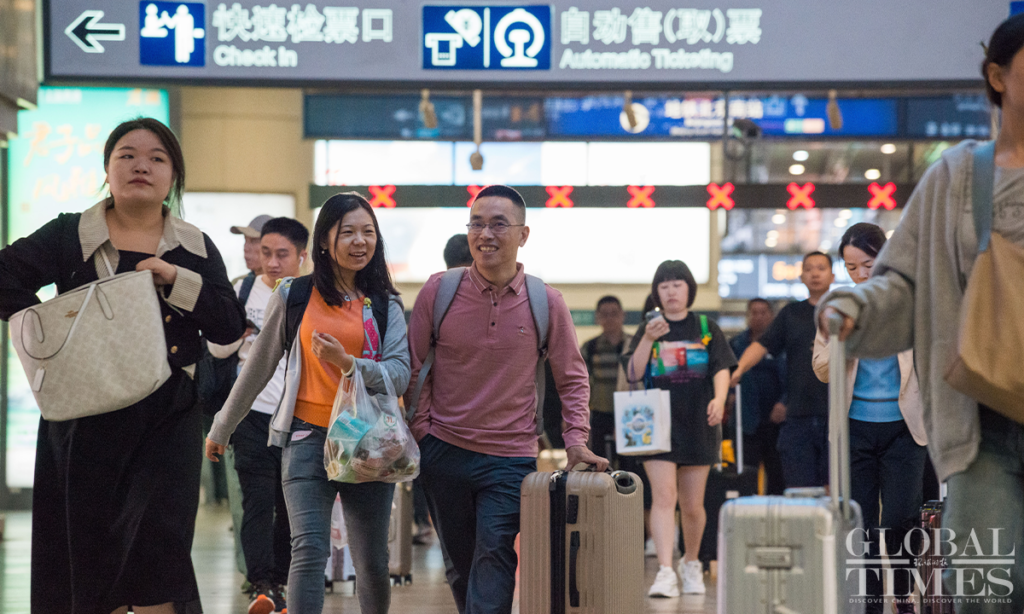The “Super Golden Week,” which combines the Mid-Autumn Festival and the National Day holidays, officially begins, as rail transportation of the holiday started on Wednesday. Before this, the festive atmosphere of the two combined holidays had been fully “preheated” in all parts of the country. On social media and in daily life, the destination of the holidays has become a hot topic of discussion and even greeting words among acquaintances during these days. Anyone who is in Chinese society, or who has crossed paths with it, can easily feel the Chinese people’s eagerness and anticipation of this long vacation have formed a heat.
This heat is intuitively reflected in the tourism data of this long vacation. Judging from the existing statistics or predictions, this year’s “Super Golden Week” presents four obvious characteristics.
First, China’s domestic tourism is seeing “full bloom.” Cities that go viral online, such as Hangzhou and Changsha, are highly popular, while remote areas, including Xinjiang and Xizang (Tibet), have also attracted a large number of tourists. In addition, “dark horses” appeared among tier-three to -five cities, such as Zibo, East China’s Shandong Province, and Yanbian, Northeast China’s Jilin Province.
Second, outbound travel has grown strongly, as places like Japan, South Korea, Southeast Asia, Europe and Central Asia have seen a surge of Chinese tourists and it is hard to even find accommodation in some of these destinations.
Third, the proportion of long-distance travel has increased significantly. Data show that 37 percent of travelers plan to travel for six to eight nights, an increase of 3 percentage points from pre-COVID 2019. This has also become an obvious change in China’s holiday tourism over the past three years.
Fourth, the trend of integration of culture, sports and tourism is obvious. In addition to traditional tourism programs, concerts, music festivals and camping attract many young consumers, and rural tourism routes, including the “Village Super League” and “Village BA,” are getting hot.
Various data show that the scale of passengers during this “Super Golden Week” is likely to break a new record. The scale of the huge crowds counted in billions of people at a given time is unimaginable in most countries, and it probably only occurs during China’s Golden Week holidays and Spring Festival, with a distinctly Chinese characteristics. Although tourism does not account for a large proportion of China’s consumption, it is a wind vane, an important symbol of the improvement of Chinese people’s quality of life, a reflection of the society’s strong desire to pursue a better life, and one of the most important sources of China’s strong economic resilience.
The bustling scenes of the “Super Golden Week” will, to a certain extent, help boost confidence in the Chinese economy. This is crucial. Throughout this year, there has been a crescendo of voices from the US and the West that badmouth the Chinese economy, searching for and piecing together materials. The true situation of the “Super Golden Week” will render most of these pessimistic arguments illogical and factually unsupported, essentially debunking themselves. The Golden Week will demonstrate the vitality and potential of China’s economy and consumer market. However, it’s important to note that the vigor and potential of China’s economy and consumer market are not proven only by the Golden Week.
It needs to be emphasized that the “Super Golden Week” is more than just about the economy. From holidays, such the National Day and the Spring Festival, we can see the most authentic way of life and philosophy of the Chinese people: They aspire to lead good lives, advocate goodwill toward others, and have no interest in interfering with others’ lives or being confrontational. This forms solid public support for China’s path of peaceful development. Everything China does is aimed at providing a better life for its people and development opportunities for people worldwide.
China, with its advantage of a vast market, still possesses significant influence over the external economic environment. Many neighboring countries are looking forward to this Golden Week to boost industries related to their local tourism. This is precisely a concrete manifestation of how China provides development opportunities for other countries.
The more valuable significance of observing the “Super Golden Week” lies in the fact that it demonstrates that China, in every aspect, is far from reaching the peak of its modernization process. People’s expectations for consumption and their pursuit of a higher quality of life are far from being fully realized. Vacations represent a way of life that should never be exclusive to developed societies in the West; Chinese people have every right to live such lives as well. The stronger this pursuit becomes, the greater the internal impetus to China’s economic development is.
During the upcoming holidays that are about reunion and gathering, most Chinese people can temporarily set aside their demanding work and fully enjoy the relaxation of the holidays. This in itself showcases and accumulates the momentum for Chinese society to move forward.
(Global Times)




